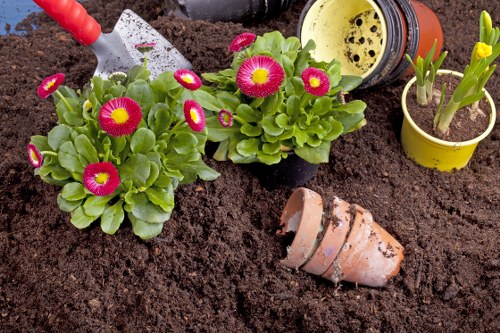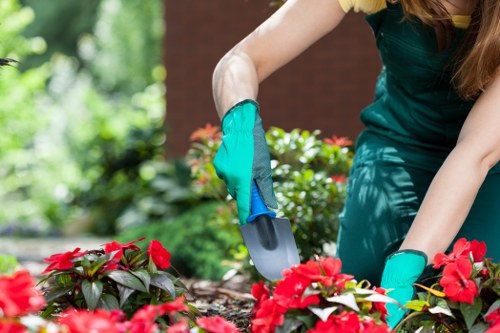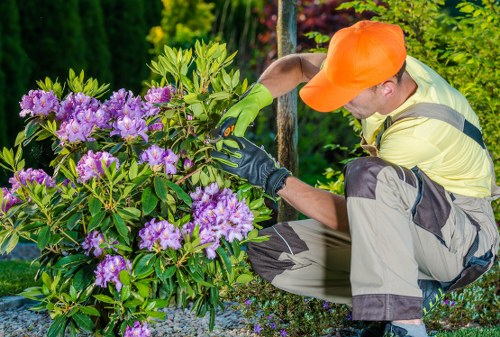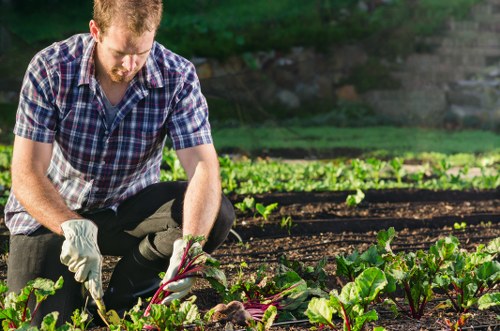Garden Fence Installation in Lawn Turf Installation

Introduction to Garden Fence and Lawn Turf Installation
Creating a beautiful and functional garden involves several key elements, two of which are the installation of a sturdy garden fence and the laying of lush lawn turf. These components not only enhance the aesthetic appeal of your outdoor space but also provide essential benefits such as privacy, security, and a well-maintained landscape.
Integrating garden fence installation with lawn turf installation can streamline your landscaping project, ensuring a cohesive and harmonious environment. This article delves into the steps, materials, and best practices for successfully installing both garden fences and lawn turf, offering valuable insights for both beginners and seasoned gardeners.
By understanding the interplay between fencing and turf, you can create a garden that is both beautiful and practical, tailored to your specific needs and preferences.

Planning Your Garden Fence Installation
Assessing Your Garden’s Needs
Before embarking on garden fence installation, it’s crucial to assess your garden’s specific needs. Consider factors such as:
- Purpose: Determine whether the fence is primarily for privacy, security, decoration, or containment of pets and children.
- Height and Length: Measure the area where the fence will be installed to decide on the appropriate height and length.
- Material: Choose materials that complement your garden’s aesthetic and are suitable for your climate, such as wood, vinyl, metal, or composite materials.
- Local Regulations: Check local zoning laws and property regulations to ensure compliance with height restrictions and material guidelines.
Selecting the Right Fence Material
Selecting the appropriate material for your garden fence is essential for durability and visual appeal. Here are some common options:
- Wood: Offers a natural and classic look, easily customizable with paint or stain.
- Vinyl: Low maintenance and resistant to weathering, available in various styles and colors.
- Metal: Provides a sleek, modern appearance and offers robust security features.
- Composite: Combines wood fibers and plastic, offering durability with a wood-like appearance.

Preparing the Site for Installation
Measuring and Marking the Fence Line
Accurate measurement and marking are critical steps in fence installation. Follow these steps to prepare your site:
- Measure the Perimeter: Use a measuring tape to determine the exact length where the fence will be installed.
- Mark the Layout: Use stakes and string to outline the fence line, ensuring it is straight and follows the desired path.
- Check for Utility Lines: Before digging, contact local utility companies to mark any underground lines to avoid accidents.
- Determine Fence Post Placement: Based on the fence height and material, decide the spacing between posts, typically between 6 to 8 feet apart.
Preparing the Ground
Proper ground preparation ensures the stability and longevity of your fence. Steps include:
- Clear the Area: Remove any obstacles, debris, or vegetation along the fence line.
- Digging Post Holes: Use a post-hole digger to create holes at the marked intervals, typically 2 feet deep for sturdy support.
- Adding Gravel: Pour a few inches of gravel into each hole for drainage, preventing water from accumulating around the posts.

Installing the Garden Fence
Setting the Fence Posts
Properly setting fence posts is crucial for the stability of the entire structure. Follow these steps:
- Position the Posts: Place each post in its respective hole, ensuring it is upright and aligned with the fence line.
- Level the Posts: Use a spirit level to make sure each post is plumb vertically.
- Secure with Concrete: Pour concrete into the hole around the post, filling it to about 6 inches below ground level. Allow the concrete to cure as per manufacturer instructions.
- Temporary Support: Brace the posts temporarily until the concrete sets, ensuring they remain stable.
Attaching Fence Panels or Rails
Once the posts are set, it's time to attach the fence panels or rails:
- Rail Method: Attach horizontal rails between the posts, then secure vertical pickets to the rails.
- Panel Method: Hang pre-fabricated fence panels directly onto the posts using brackets or screws.
- Ensure Alignment: Make sure each panel or rail is level and evenly spaced for a professional finish.

Lawn Turf Installation Process
Choosing the Right Turf
Selecting the appropriate lawn turf is essential for a healthy and vibrant lawn. Consider the following:
- Grass Type: Choose between warm-season grasses like Bermuda or cool-season grasses like Kentucky Bluegrass based on your climate.
- Sunlight Exposure: Ensure the turf variety you select thrives in the sunlight conditions of your garden, whether full sun or partial shade.
- Soil Compatibility: Match the turf type to your soil conditions to promote strong root growth and resilience.
Preparing the Soil
Proper soil preparation sets the foundation for a successful lawn turf installation:
- Clear the Area: Remove existing vegetation, rocks, and debris from the installation site.
- Grade the Soil: Ensure the ground is level and has a slight slope away from buildings to facilitate drainage.
- Amend the Soil: Incorporate organic matter or fertilizer as needed to improve soil fertility and structure.
- Compact the Soil: Lightly rake and tamp the soil to create a firm, even surface for laying turf.

Installing the Lawn Turf
Laying the Turf Pieces
Follow these steps to lay your lawn turf properly:
- Start Along a Straight Edge: Begin laying turf along a straight boundary, such as a fence or driveway edge.
- Stagger the Seams: Offset the joints between turf pieces in a brick-like pattern to enhance stability and appearance.
- Ensure Tight Fit: Press the edges of each turf piece firmly against its neighbors to eliminate gaps and prevent weed growth.
- Trim Excess Turf: Use a sharp knife to cut and fit turf pieces around obstacles and edges for a neat finish.
Watering and Maintenance
Proper watering and maintenance are vital for establishing a healthy lawn:
- Initial Watering: Water the newly laid turf thoroughly within 30 minutes of installation.
- Consistent Moisture: Keep the turf consistently moist for the first few weeks to encourage root establishment.
- Regular Mowing: Begin mowing once the turf reaches about 3 inches in height, cutting to a height of 2 inches.
- Fertilization: Apply a balanced fertilizer to promote growth and strength.

Integrating Fence and Turf for a Cohesive Garden
Design Considerations
When combining garden fence installation with lawn turf installation, consider the following design elements:
- Style Coordination: Choose fence styles and turf types that complement each other and the overall garden theme.
- Color Harmony: Select colors that enhance the natural hues of your plants and turf, creating a balanced and inviting space.
- Functional Zones: Define different areas of your garden, such as seating areas or play zones, using the fence and turf to delineate spaces.
Maintenance Synergy
A well-planned garden ensures that both the fence and the turf are easy to maintain:
- Access for Maintenance: Ensure that the fence does not obstruct access to key areas of the lawn for mowing and care.
- Protecting the Fence: Use edging materials or protective barriers to prevent turf from encroaching on the fence and causing damage.
- Consistent Upkeep: Regularly inspect both the fence and the turf for signs of wear or damage, addressing issues promptly to maintain the garden’s integrity.

Benefits of Combining Garden Fence and Lawn Turf Installation
Enhanced Aesthetic Appeal
Integrating a garden fence with lawn turf creates a visually appealing landscape that is both structured and natural. The contrast between the hard lines of the fence and the soft greenery of the turf adds depth and interest to your garden.
Improved Functionality
A combined approach ensures that your garden is both beautiful and practical. The fence provides boundaries and security, while the turf offers a comfortable and versatile space for various activities.
Increased Property Value
A well-maintained garden with elegant fencing and lush turf can significantly boost the curb appeal and market value of your property.

Common Challenges and Solutions
Poor Soil Conditions
Solution: Amend the soil with organic matter and ensure proper drainage to create an optimal environment for both the fence and the turf.
Inadequate Sunlight
Solution: Choose shade-tolerant grass varieties and consider installing fences that allow sunlight to penetrate, preventing the area from becoming too dark.
Maintaining Fence Stability
Solution: Use high-quality materials and proper installation techniques, such as setting posts in concrete, to ensure long-lasting fence stability.

Expert Tips for Successful Installation
Plan Ahead
Thorough planning is essential for a seamless installation process. Create a detailed layout, gather all necessary materials, and allocate sufficient time for each phase of the project.
Use Quality Materials
Investing in high-quality fencing and turf materials can save time and money in the long run by reducing maintenance needs and extending the lifespan of your installations.
Seek Professional Help When Needed
Don’t hesitate to consult with landscaping professionals for advice or assistance, especially for complex installations or when dealing with challenging terrain.

Conclusion
Combining garden fence installation with lawn turf installation is an effective way to create a beautiful, functional, and cohesive outdoor space. By carefully planning each step, selecting the right materials, and adhering to best practices, you can achieve a stunning garden that enhances your property's appeal and provides a welcoming environment for relaxation and activities.
Whether you're embarking on a new landscaping project or renovating an existing garden, integrating these two elements will significantly contribute to the overall success and enjoyment of your outdoor area.
Contact us today to begin transforming your garden with expert fence and turf installation services.

Frequently Asked Questions
How long does garden fence installation take?
The duration of garden fence installation depends on factors such as the fence type, length, and complexity of the design. On average, a standard fence installation can take anywhere from a few days to a week.
What is the best time of year to install lawn turf?
The optimal time for lawn turf installation is during the spring or early autumn when temperatures are moderate, and there is sufficient rainfall to promote root establishment.
Can I install a garden fence myself?
While DIY fence installation is possible for those with basic skills and tools, hiring a professional ensures precise installation, adherence to local regulations, and long-term durability.

Additional Resources
Book your service now and take the first step towards a stunning garden that combines the best of fencing and turf.